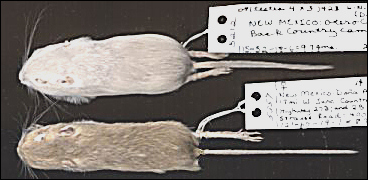

Animals matching the background where they are active are better survivors than those that contrast. The reason is quite simple: predators more easily spot the contrasters than the conformers. Color in laboratory mice has long been the focus of genetical studies. As a result, more than 100 genes are known to affect color. This doesn't tell us which genes are important for evolution out in the real world, but we're beginning to sort them out.
In the southeastern United States, deer mice living in beach habitats
are lighter than those living in heavily vegetated areas, thanks to a minor change in
one gene that's responsible for an appreciable proportion of the lightness of color
in the beach bums. Confirming that even very different animals share much of their
genetic makeup, it's been found that three light-colored species of lizards living
on White Sands, New Mexico, not only have the same gene as the mice, but likewise have
it mutated in such ways as to decrease dark pigments. Wearing white genes is definitely
the in thing at White Sands!

Contributor: Arthur H. Harris, Laboratory for Environmental Biology, Centennial Museum, University of Texas at El Paso.
Desert Diary is a joint production of the Centennial Museum and KTEP National Public Radio at the University of Texas at El Paso.

Prey animals tend to evolve by natural selection to match their background. The light colored Apache Pocket Mouse(Perognathus apache) is from White Sands, Otero Co., New Mexico, whereas the darker specimen is from the tan sands of Doña Ana County, New Mexico.
Pennisi, E. 2005. Color genes help mice and lizards. Science 309:374-375.